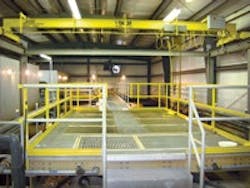Express Efficiency
Removal of various pollutants in wastewater is a costly process that requires intensive energy input and the addition of chemicals. But a new process is proving to achieve the same results in a sustainable manner, saving more than 50% of energy and 100% of supplemental carbon sources than conventional wastewater treatment processes.
Rising Costs
In conventional wastewater treatment, approximately half of the total energy consumed is used to maintain a high dissolved oxygen (DO) concentration in the aeration tank to remove the organic matter and ammonia in wastewater. Membrane bioreactors (MBR) are gaining popularity in wastewater treatment due to their ability to produce high-quality treated effluent.
Aeration energy intensity, however, can increase when membrane technology is used, due to the cleaning requirements to prevent fouling on the membrane surface. Further, supplemental carbon sources, such as methanol, may be added to an anoxic tank to enhance nitrogen removal. The increasing cost of energy and carbon sources and stringent wastewater discharge requirements on nitrogen and phosphorus are the main drivers for large water and wastewater utilities to seek new opportunities for sustainable design and operation of wastewater treatment plants.
Technology Summary
A cost-effective wastewater treatment and nutrient removal process, NPXpress, was developed by scientists and engineers at the Innovation and Environmental Stewardship Department of American Water to produce high-quality treated effluent while using less oxygen and carbon sources. The operating condition of the process promotes growth of a type of microorganism that is able to remove nitrogen and phosphorus in wastewater. These microorganisms require less oxygen and carbon sources to convert ammonia nitrogen to nitrogen gas compared with conventional bacteria found in wastewater treatment systems.
NPXpress technology has been successfully implemented at several full-scale MBR plants treating municipal wastewater, and has been proven to produce high-quality treated effluent while using less oxygen and carbon source compared to conventional MBR systems.
Take, for example, two New Jersey wastewater treatment plants in Mapleton and Jefferson Peaks. Both plants use MBR to treat domestic wastewater generated from the nearby communities in their service areas, and the high-quality effluent is discharged to groundwater. As a result of the NPXpress technology implementation, the aeration energy consumption at the wastewater treatment plants has been reduced by up to 50%, and the need to add supplemental carbon (micro-C) has been eliminated. During and after the implementation of the technology, the plants were able to consistently achieve good performance in terms of total nitrogen removal, with no negative effects observed at the plants. In addition, due to the implementation of the technology, enhanced biological phosphorus removal was observed as a side benefit for nutrient removal.
Energy Savings
As a result of the implementation of NPXpress, overall energy consumption (kilowatt-hours per month) was reduced by approximately 30% at the Mapleton plant. The energy intensity in terms of kilowatt-hours per million gallons of wastewater treated at the plant also was reduced by approximately 30%.
As a result of implementing the technology at the Jefferson Peaks plant, overall energy consumption for the plant (kilowatt-hours per month) was reduced by approximately 50% and cost savings were approximately 54%. The additional savings were attributed to the reduced demand charges from the electric company.
The implementation of the nutrient removal technology requires minimum capital improvement to the existing wastewater treatment plants. The simple payback period was calculated by comparing the capital investment and the savings for the two full-scale plants. The simple payback periods for Mapleton and Jefferson Peaks were 3.1 months and 4.6 months, respectively.
Carbon Source Savings
Since conversion to NPXpress, the Jefferson Peaks and Mapleton plants have eliminated
supplemental carbon and achieved further
savings on chemical and related operation
and maintenance costs.
The technology was awarded a patent in September 2011. Since then, it has been installed at six other American Water wastewater treatment plants as part of the company’s overall green initiatives. The technology has demonstrated promising capabilities to achieve wastewater treatment and nutrient removal in a sustainable way and provided opportunities for wastewater utilities to design, build, and operate an energy-neutral wastewater treatment plant.
Download: Here
